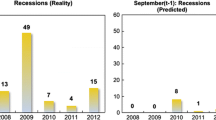Abstract
We examine the quantitative forecasts of Wall Street Journal economists made during the Great Recession. The recession was not predicted in advance, and the severity of the decline was not recognized immediately. An important problem was that the real-time data did not reflect the actual state of the economy and contributed to the forecast errors. At times there was substantial disagreement among the forecasters. A time-series forecast disagreement might provide valuable information about impending recessions.


Similar content being viewed by others
Notes
Previous studies have examined forecasts published in the Wall Street Journal, but these have primarily analyzed interest rate or exchange rate predictions. [Cho 1996; Kolb and Stekler 1996 ; Greer 1999 and 2003; Eisenbeis and others 2002; Mitchell and Pearce 2005].
Although the numbers are slightly different, the mean and median forecasts have the same patterns.
A much smaller percentage of the economists made negative growth forecasts in June through September 2008.
The minutes of the FOMC meetings are published 21 days after the end of each meeting. The website is www.federalreserve.gov/monetarypolicy/fomcminutes.
The MAE of forecasts made a quarter in advance is about 75 percent of the mean absolute change. It is over 80 percent for the two quarter-ahead forecasts. The ratio of MAE to the mean absolute change is a comparison of the accuracy of the forecasters relative to the predictions of the no-change naïve model. This model predicts that the path of the economy will not change. The large forecast errors for one and two quarters ahead relative to the naive model may indicate a lack of understanding by the economists of the basic underlying dynamic trends in the economy.
There is a third possible concept: the disagreement among forecasters for all forecast horizons in a particular survey. This measure is obtained by averaging the standard deviations over all the horizons for which predictions were made. As an illustration, suppose that a particular survey contains predictions for the current quarter and one and two quarters ahead. In that case, we calculate the standard deviation of the forecasts made for each of those three horizons and then use the average of the three standard deviations as the measure of disagreement among economists at that time. One can view this as a measure of the disagreement about the direction of the economy over a period of time. The results for this measure of disagreement are similar to those for fixed events that we present below.
Lahiri and Sheng measure between-agent variation as the difference between an agent's mean forecast over time and the overall mean forecasts over time and across agents.
Economists do make forecasts based on analogies [Goldfarb and others 2005].
On this subject see Schnader and Stekler [1998]. A reviewer notes that many of the WSJ forecasters are in the financial sector and may have had self-interest in not recognizing the bad news for their sector.
References
Cho, D.W . 1996. “Forecast Accuracy: Are Some Business Economists Better Than Others?” Business Economics, 31 (4): 45–49.
Dopke, J., and U. Fritsche . 2006. “When Do Forecasters Disagree? An Assessment of German Growth and Inflation Forecast Dispersion.” International Journal of Forecasting, 22 (1): 125–135.
Dovern, J., U. Fritsche, and J. Slacalek . 2009. “Disagreement among Forecasters in G7 Countries,” European Central Bank, Working Paper 2009.
Eisenbeis, R., D. Waggoner, and T. Zha . 2002. “Evaluating Wall Street Journal Survey Forecasters: A Multivariate Approach,” Federal Reserve Bank of Atlanta Working Paper 2002-8a.
Enzler, J., and H.O. Stekler . 1971. “An Analysis of the 1968–9 Economic Forecasts.” Journal of Business, 44 (3): 271–281.
Fildes, R., and H.O. Stekler . 2002. “The State of Macroeconomic Forecasting.” Journal of Macroeconomics, 24 (4): 435–468.
Fintzen, D., and H.O. Stekler . 1999. “Why Did Forecasters Fail to Predict the 1990 Recession?” International Journal of Forecasting, 15 (1): 83–91.
Goldfarb, R., H.O. Stekler, and J. David . 2005. “Methodological Issues in Forecasting: Insights from the Egregious Business Forecast Errors of Late 1930.” Journal of Economic Methodology, 12 (4): 517–542.
Greer, M.R . 1999. “Assessing the Soothsayers: An Examination of the Track Record of Macroeconomic Forecasting.” Journal of Economic Issues, 33 (1): 77–94.
Greer, M.R . 2003. “Directional Accuracy Tests of Long-Term Interest Rate Forecasts.” International Journal of Forecasting, 19 (2): 291–298.
Heilemann, U . 2002. “Increasing the Transparency of Macroeconometric Forecasts: A Report from the Trenches.” International Journal of Forecasting, 18 (1): 85–105.
Isiklar, G., and K. Lahiri . 2007. “How Far Ahead Can We Forecast? Evidence from Cross-Country Surveys.” International Journal of Forecasting, 23 (2): 167–187.
Kolb, R., and H.O. Stekler . 1996. “Is there a Consensus among Financial Forecasters?” International Journal of Forecasting, 12 (4): 455–454.
Lahiri, K., and X. Sheng . 2010. “Measuring Forecast Uncertainty by Disagreement: The Missing Link.” Journal of Applied Econometrics, 25 (4): 514–538.
Lundquist, K., and H.O. Stekler . 2012. “Interpreting the Performance of Business Economists During the Great Recession.” Business Economics, 47 (2): 148–154.
Mitchell, K., and D.K. Pearce . 2005. “Professional forecasts of interest rates and exchange rates: Evidence from the Wall Street Journal's panel of economists,” mimeo.
Schnader, M.H., and H.O. Stekler . 1998. “Sources of Turning Point Errors.” Applied Economics Letters, 5 (8): 519–521.
Zarnowitz, V., and P. Braun . 1993. “Twenty Two Years of the NBER-ASA Quarterly Economic Outlook Surveys: Aspects and Comparisons,” in Business Cycles, Indicators, and Forecasting, edited by J.H. Stock and M.W. Watson. Chicago University Press, 11–93.
Additional information
*Herman O. Stekler is a Research Professor at George Washington University. He has written extensively on forecasting issues.Raj M. Talwar is a Business Intelligence Analyst at Hewlett-Packard. He received a B.S. in Economics and Statistics from the George Washington University in 2011.
Rights and permissions
About this article
Cite this article
Stekler, H., Talwar, R. Forecasting the Downturn of the Great Recession. Bus Econ 48, 113–120 (2013). https://doi.org/10.1057/be.2013.4
Published:
Issue Date:
DOI: https://doi.org/10.1057/be.2013.4




